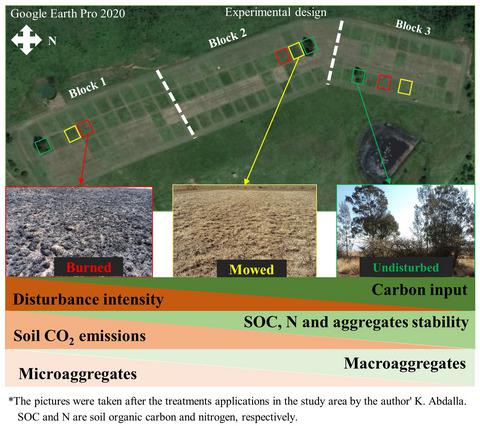当前位置:
X-MOL 学术
›
Glob. Change Biol.
›
论文详情
Our official English website, www.x-mol.net, welcomes your
feedback! (Note: you will need to create a separate account there.)
Long-term (64 years) annual burning lessened soil organic carbon and nitrogen content in a humid subtropical grassland
Global Change Biology ( IF 10.8 ) Pub Date : 2021-10-04 , DOI: 10.1111/gcb.15918 Khatab Abdalla 1, 2, 3 , Pauline Chivenge 3, 4 , Philippe Ciais 5 , Vincent Chaplot 3, 6
Global Change Biology ( IF 10.8 ) Pub Date : 2021-10-04 , DOI: 10.1111/gcb.15918 Khatab Abdalla 1, 2, 3 , Pauline Chivenge 3, 4 , Philippe Ciais 5 , Vincent Chaplot 3, 6
Affiliation

|
Burning has commonly been used to increase forage production and nutrients cycling in grasslands. However, its long-term effects on soil organic carbon (SOC) and nitrogen (N) pools within the aggregates and the relation between aggregates-associated SOC and soil CO2 emissions need further appraisal. This study evaluated the effects of 64 years of annual burning on SOC and N dynamics compared to annual mowing and undisturbed treatments in a grassland experiment established in 1950. Soils were sampled from four depths representing the upper 30 cm layer and fractionated into macroaggregates, microaggregates and silt + clay fractions. The macroaggregates were further fractionated into three occluded fractions. The SOC in the bulk soil and aggregates were correlated to soil CO2 effluxes measured under field conditions. Compared to the undisturbed treatment, annual burning decreased aggregates stability, SOC and N in the upper 30 cm layer by 8%, 5% and 12%, respectively. Grassland mowing induced greater aggregates stability than burning only in the upper 5 cm. Burning also decreased SOC in the large macroaggregates (e.g., 0–5 cm) compared to mowing and the undisturbed grasslands but proportionally increased the microaggregates and their associated SOC. Soil N associated with aggregates decreased largely following grassland burning, for example, by 8.8-fold in the microaggregates within the large macroaggregates at 20–30 cm compared to the undisturbed grassland. Burning also increased soil CO2 emissions by 33 and 16% compared to undisturbed and mowing, respectively. The combustion of fresh C and soil organic matter by fire is likely responsible for the low soil aggregation, high SOC and N losses under burned grassland. These results suggested a direct link between grass burning and SOC losses, a key component for escalating climate change severity. Therefore, less frequent burning or a rotation of burning and mowing should be investigated for sustainable grasslands management.
中文翻译:

长期(64 年)年燃烧减少了湿润亚热带草原土壤有机碳和氮含量
燃烧通常用于增加草原的草料产量和养分循环。然而,其对团聚体内土壤有机碳(SOC)和氮(N)库的长期影响以及与团聚体相关的SOC与土壤CO 2排放之间的关系需要进一步评估。本研究在 1950 年建立的草地试验中,与每年割草和未受干扰的处理相比,评估了 64 年每年燃烧对 SOC 和 N 动态的影响。从代表上层 30 cm 层的四个深度取样土壤,并分成大团聚体、微团聚体和淤泥 + 粘土部分。大聚集体进一步分成三个封闭的部分。大块土壤和团聚体中的 SOC 与土壤 CO 2相关在现场条件下测量的流出量。与未受干扰的处理相比,年燃烧使上层 30 cm 层的团聚体稳定性、SOC 和 N 分别降低了 8%、5% 和 12%。与仅在上部 5 厘米处燃烧相比,草地割草引起更大的聚集体稳定性。与割草和未受干扰的草原相比,燃烧还降低了大团聚体(例如 0-5 厘米)的 SOC,但按比例增加了微团聚体及其相关的 SOC。与未受干扰的草地相比,与团聚体相关的土壤氮在草地燃烧后大幅减少,例如,在 20-30 厘米的大型团聚体中,微团聚体中的微团聚体减少了 8.8 倍。燃烧也增加了土壤 CO 2与未受干扰和割草相比,排放量分别减少了 33% 和 16%。火对新鲜碳和土壤有机质的燃烧可能是燃烧草地下土壤团聚率低、SOC 和 N 损失高的原因。这些结果表明,草燃烧与 SOC 损失之间存在直接联系,而 SOC 损失是导致气候变化严重性升级的关键因素。因此,为了可持续的草原管理,应该研究减少燃烧频率或燃烧和割草的轮换。
更新日期:2021-11-12
中文翻译:

长期(64 年)年燃烧减少了湿润亚热带草原土壤有机碳和氮含量
燃烧通常用于增加草原的草料产量和养分循环。然而,其对团聚体内土壤有机碳(SOC)和氮(N)库的长期影响以及与团聚体相关的SOC与土壤CO 2排放之间的关系需要进一步评估。本研究在 1950 年建立的草地试验中,与每年割草和未受干扰的处理相比,评估了 64 年每年燃烧对 SOC 和 N 动态的影响。从代表上层 30 cm 层的四个深度取样土壤,并分成大团聚体、微团聚体和淤泥 + 粘土部分。大聚集体进一步分成三个封闭的部分。大块土壤和团聚体中的 SOC 与土壤 CO 2相关在现场条件下测量的流出量。与未受干扰的处理相比,年燃烧使上层 30 cm 层的团聚体稳定性、SOC 和 N 分别降低了 8%、5% 和 12%。与仅在上部 5 厘米处燃烧相比,草地割草引起更大的聚集体稳定性。与割草和未受干扰的草原相比,燃烧还降低了大团聚体(例如 0-5 厘米)的 SOC,但按比例增加了微团聚体及其相关的 SOC。与未受干扰的草地相比,与团聚体相关的土壤氮在草地燃烧后大幅减少,例如,在 20-30 厘米的大型团聚体中,微团聚体中的微团聚体减少了 8.8 倍。燃烧也增加了土壤 CO 2与未受干扰和割草相比,排放量分别减少了 33% 和 16%。火对新鲜碳和土壤有机质的燃烧可能是燃烧草地下土壤团聚率低、SOC 和 N 损失高的原因。这些结果表明,草燃烧与 SOC 损失之间存在直接联系,而 SOC 损失是导致气候变化严重性升级的关键因素。因此,为了可持续的草原管理,应该研究减少燃烧频率或燃烧和割草的轮换。










































 京公网安备 11010802027423号
京公网安备 11010802027423号